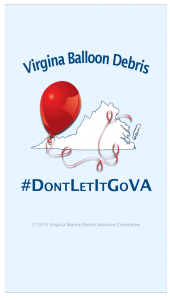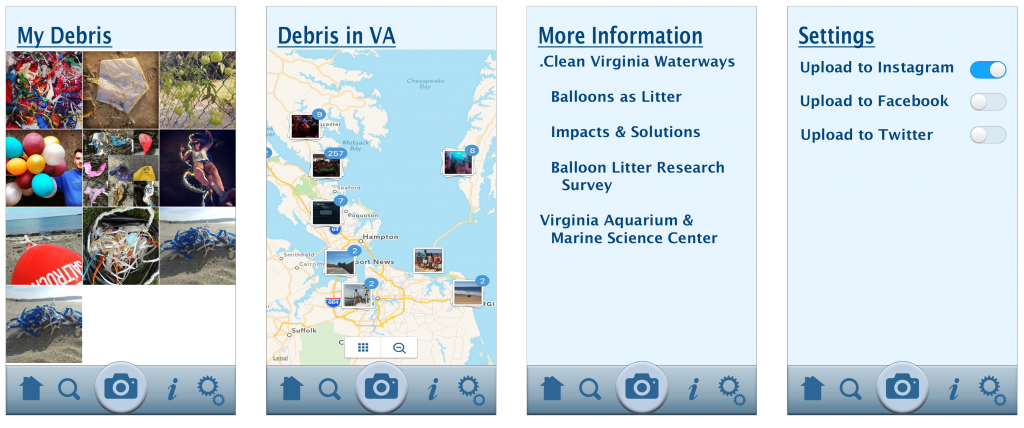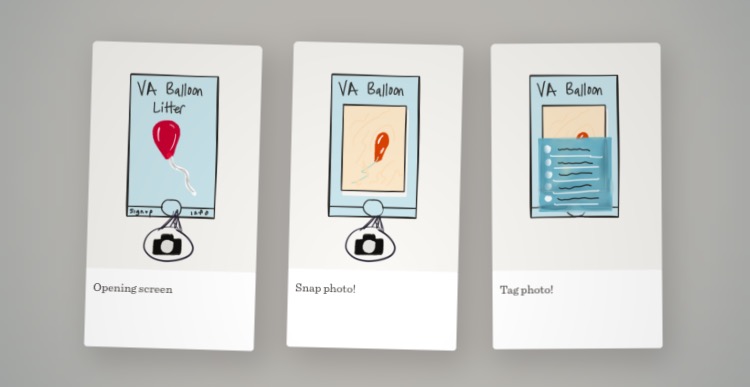Still working on the backend!
Edit: Don’t know why it’s blurry! Sorry about that!

Still working on the backend!
Edit: Don’t know why it’s blurry! Sorry about that!
I have been working on the visuals and general layout of the balloon debris app, with the goal of making a more usable version of the Virginia Balloon Study web form. The app can be promoted via social media to students, concerned citizens, and clean-up volunteers, and the information gathered will be of use to a variety of stake-holders, including Clean Virginia Waterways (CVW), Virginia’s Coastal Zone Management Program (CZMP) and the Virginia Marine Debris Advisory Committee. I will be sending this draft to the above stake-holders and making adjustments based on feedback.
I plan to have a working demo-version of this app to present at the SeaGrant Symposium in January.
Overview of App
Splash Screen
The Splash Screen is the screen that will be displayed when the app is launched on the device.

Splash screen showing the name of the app (Virginia Balloon Debris), logo, and hashtag #DontLetItGoVA
Tips
The series of images below shows the first launch tips screen, with each tip popping up successively as the user taps through.
Standard View
This is what the user will see first every time the app is launched.
The information gathered regarding Material, Burst/Deflated, Attachments, Type of String, Animal Entangled, and Comments can be collected in a database, such as the one already in use by Clean Virginia Waterways and the Virginia Aquarium.

Once the user snaps a photo, the app will automatically display pop-up selections with radio buttons so that adequate information is gathered regarding the image.
Other Screens – Home, Search, Info and Settings

The Home button brings up a view of all images the user has taken. Search shows a pin-in-map view of other debris reports from around the state. Information displays links that the user can navigate to in order to learn more (launches in browser). Settings allows the user to automatically post the images taken to favorite social media, with the hashtags #DontLetItGoVA and #BalloonDebris.
Marine debris is an issue of local, national, and global concern, impacting all oceans and waterways. The National Oceanic and Atmospheric Administration (NOAA) defines marine debris as any persistent solid material that is manufactured or processed and directly or indirectly, intentionally or unintentionally, disposed or abandoned into the marine environment or the Great Lakes. This broad definition encompasses everythingfrom derelict fishing gear to microplastics. The Commonwealth of Virginia developed a Marine Debris Reduction Plan (MDRP) in 2014 in order to address this problem through Virginia policies and programs. It is estimated that 49% of all marine debris in the U.S. comes from land-based sources, with 18% coming from ocean-based sources and the remaining 33% made up of items that could come from land or ocean-based sources (Sheavly, 2007). Marine life can easily mistake plastic bags, balloons, and other debris as a food source or ingest it accidentally during normal feeding. These items can become lodged in the throat or digestive track and damage the gut, resulting in malnutrition or death. Entanglement in marine debris is also a serious hazard.
My Master’s thesis research addresses microplastic pollution and the sorption of persistent, bioaccumulative, and toxic organic contaminants (PBTs) often found in marine waters. Specifically, I am investigating how bio-based, biodegradable plastics compare to traditional plastics in terms of sorption of PBTs. Microplastics are defined as pieces of plastics that are <5mm in size, and are either intentionally manufactured or are the result of the breakdown of larger plastic debris. Their small size corresponds to an increase in surface area, which allows for the enhanced sorption of chemical contaminants. Various organisms, including zooplankton (Cole, 2013) and oysters (van Cauwenberghe, 2014) can then ingest these contaminated microplastics, potentially leading to the bioaccumulation and biomagnification of these chemicals. With consumers beginning to demand eco-friendly, “green” alternatives to traditional plastics, bio-based plastic market share is sure to increase (Technavio, 2014), leading to an increase in bio-plastic marine debris. Waste and coastal resource managers can then use the information supplied by my research in order to understand the potential effects of marine microplastic debris on the ecosystem.
Balloon litter has been identified by participants in the 2013 Virginia Marine Debris Summit to be of particular concern in Virginia, and also identified as “most achievable” in terms of systematic waste reduction by various stakeholders (Register, 2014). The Virginia MDRP designated development and implementation of a social marketing campaign addressing balloons as marine debris items as a part of its first set of near-term goals to be achieved by 2016. Though not an explicit part of my thesis research, my interests in marine debris as a whole has lead me to investigate this issue more closely, and that is why I am proposing to develop a smartphone application that uses citizen science data to collect information about balloon litter in Virginia, and to educate users on the impacts of balloon releases.
The product I aim to develop will be a prototype for an Apple iOS application that allows the citizen scientist to document instances of balloon litter in Virginia. Ideally, the app would allow the user to take a photo of the debris and allow for quick-select tagging of various options, including an entangled or dead animal. Location and debris information could then be uploaded and stored in a database that can then be queried for “hotspots” and filtered by location or tag. Users would also have the option to publish their photo to popular social media outlets such as Instagram, Twitter, and Facebook with automated hashtags to identify the app and purpose (i.e. #VAballoons, #VAmarinedebris, etc.). Other features of the app would include a “map view” of documented debris, information on what happens to balloons when they are released, and a page of links to more information.

Clean Virginia Waterways (CVW), Virginia’s Coastal Zone Management Program (CZMP) and the Virginia Marine Debris Advisory Committee would be the stakeholders most interested in this outreach product and my ongoing thesis research. Katie Register of CVW has expressed explicit interest in this product, and I will be working with her, Christina Trapani of EcoManiac, and Laura McKay and Virginia Witmer of CZMP to develop this application.
The benefits of this product are that it can be used as a data-gathering tool and as an educational tool for social marketing and social change. Measurable outcomes outlined in the Virginia MDRP include commitments from targeted audiences to stop mass balloon releases and a measurable reduction in balloon litter in Virginia. Balloons are unique in that people often purchase them with the intent of releasing them into the environment, as a part of a ceremony or tradition. This app can directly contribute to both of these outcomes through the interconnectedness of social media, it is possible that images and information shared by users can help to educate the general public about the hazards of balloon releases. This app can also collect data regarding balloon debris not quantified by volunteer cleanup events, contributing to the overall understanding of the issue.
Literature Cited
Cole, M.; Lindeque, P.; Fileman, E.; Halsband, C.; Goodhead, R.; Moger, J.; Galloway, T. S. Microplastic Ingestion by Zooplankton. Environ. Sci. Technol. 2013, 47, 6646-6655.
Register, K. Virginia Marine Reduction Plan. Prepared for Virginia Coastal Zone Management Program by Clean Virginia Waterways, Grant Number NA11NOS4190122 and Grant Number NA12NOS4190168. 2014.
Sheavly, S. National Marine Debris Monitoring Program: final program report, data analysis and summary. Prepared for U.S. Environmental Protection Agency by Ocean Conservancy, Grant Number X83053401-02. 2007.
Technavio. Global Biobased Polymers Market 2015-2019. 2014.
Van Cauwenberghe, L.; Janssen, C. R. Microplastics in bivalves cultured for human consumption. Environ. Pollut. 2014, 193, 65-70.
1. I once ate 2 pints of Ben & Jerry’s Phish Food Ice Cream in one sitting.
2. I lived in the woods for 6 months, showering only once a week before starting graduate school.
3. I studied how lasers effect optical properties of glass as an undergraduate.
So which is which? 😉